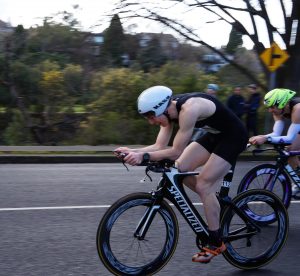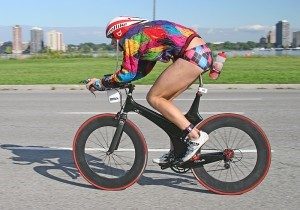Well, it’s that time of year again – The Tour de France. For many people this is the biggest cycling event on the calendar, and it is arguably the most prestigious and revered of all the grand tours. For me, and many others, The Tour is also a time of internal conflict – where a renewed burst of inspiration for fitness runs headlong into battle against the reality of the harsh, cold, Australian winter. Watching the pro peloton of lean, supremely fit climbing machines make their way over gruelling hilltop stages in the middle of the European summer, it’s easy to be inspired to get out on the bike! The problem is, it’s equally easy to wake up the following morning (already tired from your late night Tour watching antics) to a dreary grey day, misting rain and chilling temperatures and apply a favourite Aussie-ism to your training – a “yeah… nah”.
Now I, like many cyclists, am generally not a fan of the cold outdoors. Having been designated the unfortunate nickname “margarine” over winter (because I am apparently even softer than butter), it would be fair to say that winter is a time I am much less regularly seen on the road. With this in mind, I thought it may be useful to compile a list of some of the tips I have picked up from the boys over my years working with cycling teams. These tips have helped to get me through winter with only minor frostbite and just managing to desperately hang on to the few remaining skerricks of my summer fitness. So here you have it, some tips and tricks, and hopefully some encouragement!
Staying Warm
The first port of call in the battle against the cold North East Victorian winter, is investing in some warm kit. Staple items include: a fleecy overjacket, long knicks, an undershirt, and a rainproof jacket. For versatility, fleecy arm and leg warmers, and windproof vests provide you with the necessary warmth but also offer the option of being removed mid ride if you find yourself in the very unlikely situation of being too hot!
Since we lose a large percentage of our heat through feet, hands and head, it is also very important to keep peripheral areas warm. For this reason, a good quality set of gloves and shoe covers (booties) are a must. To keep your head warm, a cycling cap, buff, or bandana under your helmet are not only a bit of a cycling fashion statement, but also help prevent loss of heat through your head.
Unfortunately, the reality is, cycling kit is very expensive, so here are a couple of tips I’ve heard which won’t break the bank! To avoid having to fork out for a brand new set of fleecy knicks, purchase some warm outerwear to use over your standard knicks. Thermal compression stockings work well here (keep an eye out for the Aldi winter ski wear sale!) because they are warmer than standard compression stockings and they will not flap about in the breeze like your usual thermalwear – let’s face it, none of us want to catch as much wind as Todd Quadzilla Bird seen below in full flight during a TT (haha, see what I did there)
The following are some of the more unusual tips I have heard – which I have personally tested and can verify! Ex Team Bridgelane rider Mark O’Brien suggests keeping your feet warm by wrapping some gladwrap or a sandwich bag over your socks to prevent wind chill. Similarly, a pair of disposable plastic medical gloves under your usual gloves for shorter rides (before hands start to get a little clammy) is a great way of protecting your hands from the wind, and insulating against the cold. This is rumoured to be a popular option amongst riders in the 5:30am winter bunches!
Staying Safe
As days are getting shorter, a lot of cyclists find themselves forced to ride out into the cold, outside daylight hours. Furthermore, we often experience dull days, fog, or rainy conditions where visibility is poor on the roads. For these reasons, it is important to do everything you can to ensure that you are seen by motorists and other roads users. Bright front and rear bike lights are an absolute must in poor light conditions and an extra helmet light is also recommended, particularly if you will be riding at night. Studies have demonstrated that rear lights with a daytime flashing function offer the most effective visual aid to being seen by motorists. Having this daylight flashing function is of utmost importance as in daylight conditions, standard low lumen flashing lights do not provide much visibility. Secondary to this, with grey weather conditions, bright high visibility cycling clothing also makes you more noticeable to traffic, and can be quite attractive at the same time… Or not…
Another important safety consideration during winter is maintaining your equipment. It is all too easy to finish your ride, wet and cold, dump your bike in the garage and forget about it. Think again! In wet conditions, tyres pick up lots of road grime, which can easily make its way into your running gear. Wet weather can also cause rust in your chain and other mechanical components. In addition to this, the rubber in tyres becomes softer when wet – so check your tread regularly and always carry your spare tube and pump.
Staying Healthy
The final point in this survival guide is managing to stay fit and injury free throughout the season. Unfortunately, research shows that cold decreases the extensibility of our muscles and other soft tissues, making them more susceptible to strains and sprains during the colder months. A regular stretching and mobility program to maintain flexible strong muscles is an imperative part of reducing your injury risk. If you do choose to brave the harsh outdoors, start your ride with a short period of high cadence pedalling, beginning with a lower intensity and slowly building to a moderate intensity over the first couple of kilometres. The rapid, repetitive contraction and relaxation of large muscle groups in the legs enhances blood flow to peripheral areas, and the resultant increase in heart rate boosts your cardiovascular system, and helps maintain core temperature as well. Bottom line here is, warm muscles are more extensible muscles, and more extensible muscles are less likely to become injured muscles!
Well there you have it – hopefully these tips can assist you in staying on your bike over winter, and maintaining some good form (or at least some form) whilst the skies are grey. See you on the road!
(And by “see you” I mean see you through a window, as I sit on a comfy lounge by an open fire, drinking mulled wine and laughing smugly at anyone silly enough to actually be outside in the winter!)



